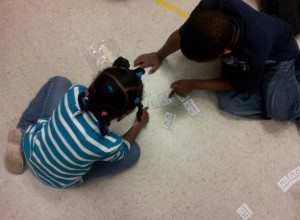
Do It Yourself: How to Take Something Simple and Make It Concert-Worthy
Who says you can’t perform what you’re doing in your classroom every day in a concert?!
This is a real series of lessons I did with my first graders starting at the beginning of April and they performed the end product on their concert, May 15. Believe me, if I can do it, so can you!
Here was my teaching process, but please feel free to adapt it however you want to fit your needs:
Day 1
Using the Smartboard, show the four “railroad rhythms”, and echo-speak them with the accurate rhythms. Then challenge the students to say it together when you point to one.
Cover up the railroad rhythms, then reveal four two-beat rhythm patterns. Have the class read and clap these patterns together.

Get rid of the screen shade and invite students to come up and connect each railroad rhythm with its matching two-beat pattern.

On the next page, the teacher picks four railroad rhythm boxes from the bottom and has the class read and clap the pattern together. Don’t forget to introduce the repeat sign, if students are not familiar with it yet.

Repeat the step above, but this time allow for one or two boxes to be repeated.

Invite each student to come up and pick a box then read and clap their rhythm patterns together. I then saved these patterns to use for the next lesson.
Day 2
Teach the class a simple song about trains. (I used “A Peanut Sat on a Railroad Track” from the Wee Sing series, but “Engine Engine Number Nine” would work well or any other short train-related song)
Perform the sixteen-beat railroad rhythms from last time in rondo with the train-related song (ie – song, rhythm #1, song, rhythm #2, etc.)
Day 3
Print off a page with two of each rhythm box, then cut the boxes out and put them in a plastic bag (make enough for half of class).

Have students work in pairs to create their own four-box pattern that they can clap and read aloud.

Have the class perform a grand rondo of the train song and partners clapping and reading their patterns. This is a great way to assess the students and I recorded two or three favorite railroad patterns to save for the next lesson.
Day 4
The teacher picks out a few untuned percussion instruments and has students vote on which ones are best for which sounds. My students chose sandpaper blocks for “chugga chugga”, hand drums for “whoo whoo”, maracas for “tsss…”, and just voices for “all aboard”.
Perform a rondo with the song and their favorite patterns from last time on instruments. Don’t forget to allow them to switch instruments a few times!
Day 5
Teach a simple bordun and other tuned or untuned percussion parts to go along with the train song. My bordun was a simple half-note beat on bass xylophones, contrabass bars, and sandpaper blocks. I also added pentatonic tone clusters on soprano xylophones and untuned percussion on word cues from the song.
Perform the song with instruments in a rondo with the rhythm patterns on the untuned percussion instruments.
Day 6 and Beyond
Keep rehearsing the different instrument parts and make sure all students get a chance on all the parts.
Eventually pick which students will play which instruments for the concert. For my school, I had only one class play instruments on this while the other two sang and two or three weeks before the concert, assigned each student in that class a specific instrument.
Add a train whistle played by the teacher to start off the song each time it happens in the rondo.
Side note: I originally wanted to have the song and patterns have a faster tempo every time (reinforcing our fast/slow tempo discussion earlier in the quarter), but it didn’t work out this time – I still think it’d be a fun performance idea though!
——————–
I hope this example of how I was able to take simple rhythms and a short song and turn it into a concert-worthy piece helps you realize that an Orff style of music-making does not have to be limited to the classroom. A program does not have to rely on simply singing with a CD to have long enough songs – allow your students to compose and use the rondo form to your advantage! Show the parents what your students are doing in their music classroom – we are not simply “singing teachers”, we are facilitating musical creation and challenging students to work together to make music!
What is your favorite way to take something simple and make it worthy of a concert performance? How do you showcase what actually goes on in your classroom for parents and families?
See all posts by Erin Clevenger
Sign up for latest Orff Tips, Lesson Plans and Advocacy Tools

Empower your students to create their own music in this free 3-day challenge with Roger Sams. (Lessons delivered via email)

Learn about the legendary factory that started it all and why so many teachers like you love our instruments.

